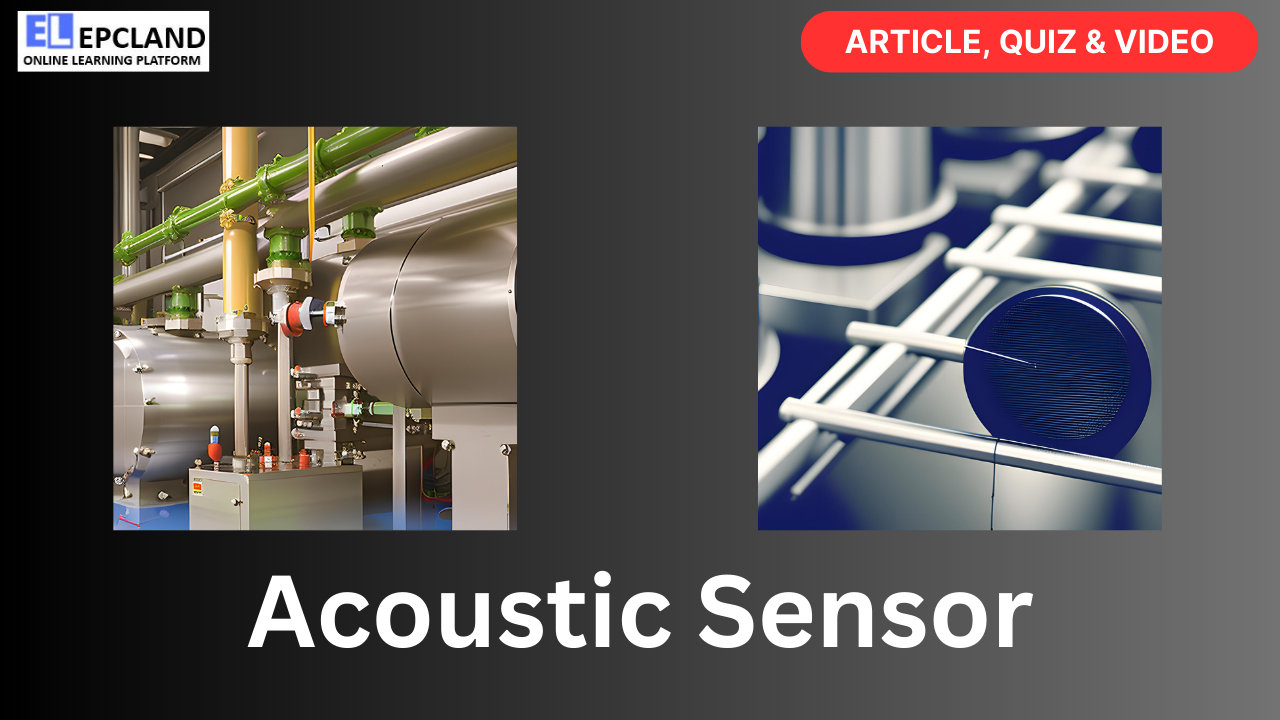Introduction
The Oil & Gas industry is characterized by its complex and hazardous operations, demanding precise control and monitoring systems to ensure safety, efficiency, and environmental compliance. In recent years, one technology has been making significant strides in transforming these aspects of the industry: acoustic sensors. Acoustic sensors, which rely on sound waves to collect data, offer a non-invasive and highly effective means of monitoring various processes in the Oil & Gas sector. In this article, we will delve into the world of acoustic sensors, exploring their principles, applications, case studies, technological advancements, challenges, and the promising future they hold for the industry.
Table of Contents
Don’t miss the Complete Course on Piping Engineering: Check Now
By EPCLand.com
Understanding Acoustic Sensors
Definition and Basic Principles
Acoustic sensors are devices designed to detect and analyze sound waves generated by various sources in the Oil & Gas industry. They work on the principle that sound waves carry valuable information about the condition and behavior of materials and equipment. By capturing and processing these sound waves, acoustic sensors can provide valuable insights into critical processes.
How Acoustic Sensors Work in the Oil & Gas Industry
In the Oil & Gas sector, acoustic sensors are employed to monitor a wide range of activities, including reservoir management, pipeline integrity, and wellbore surveillance. These sensors use microphones, accelerometers, or hydrophones to pick up acoustic signals, which are then converted into data for analysis. The resulting information allows operators to make informed decisions and optimize operations.
Types of Acoustic Sensors
Hydrophones
Hydrophones are designed to operate underwater and are crucial for activities such as offshore drilling and subsea pipeline monitoring. They excel at detecting underwater acoustic signals and pressure changes, aiding in the optimization of production rates.
Geophones
Geophones are commonly used in seismic exploration, helping identify subsurface formations and reserves. They are highly sensitive to ground vibrations and offer valuable data for reservoir characterization.
Accelerometers
Accelerometers measure vibrations and acceleration in equipment and structures. In the Oil & Gas industry, they are used to monitor the condition of pumps, compressors, and other machinery, allowing for predictive maintenance.
Advantages of Using Acoustic Sensors
- Non-invasive monitoring
- Real-time data collection
- Early detection of anomalies
- Enhanced safety and environmental protection
- Cost-effective maintenance
Applications of Acoustic Sensors in the Oil & Gas Industry
Reservoir Monitoring
Detecting Fluid Movement and Pressure Changes
Acoustic sensors help track fluid movement within reservoirs, providing critical data for reservoir management. This information allows for precise control of production rates and helps prevent reservoir damage.
Optimizing Production Rates
By continuously monitoring reservoir conditions, operators can adjust production rates in real-time to maximize recovery while minimizing operational risks.
Pipeline Monitoring
Leak Detection and Prevention
Acoustic sensors play a vital role in detecting leaks along pipelines. They can identify even small leaks before they become major issues, minimizing environmental impact and reducing repair costs.
Pipeline Integrity Assessment
Continuous monitoring with acoustic sensors helps assess the integrity of pipelines by detecting corrosion, stress, and other structural issues. This proactive approach prevents accidents and ensures the longevity of infrastructure.
Wellbore Surveillance
Monitoring Downhole Conditions
Acoustic sensors are deployed downhole to monitor pressure, temperature, and flow rates. This information aids in optimizing drilling operations and ensuring wellbore integrity.
Early Detection of Wellbore Issues
By detecting wellbore issues such as sand production or gas breakthrough early on, operators can take corrective action and prevent costly well interventions.
Safety and Environmental Protection
Emergency Response and Spill Detection
Acoustic sensors are integral in emergency response systems, detecting spills and leaks quickly to minimize environmental damage and ensure rapid intervention.
Environmental Impact Mitigation
Through continuous monitoring, acoustic sensors contribute to environmental sustainability by reducing the industry’s ecological footprint.
Don’t miss the Complete Course on Piping Engineering: Check Now
By EPCLand.com
Case Studies
Offshore Platform Monitoring
In a case study conducted by XYZ Corporation, acoustic sensors were installed on an offshore platform to monitor equipment vibrations and detect potential failures. Real-time data analysis allowed for predictive maintenance, reducing downtime and maintenance costs by 20%.
Pipeline Integrity Maintenance
Company ABC implemented an acoustic sensor network across its extensive pipeline infrastructure. This led to the early detection of a minor leak, preventing a major environmental incident and saving millions of dollars in cleanup and repair expenses.
Enhanced Reservoir Management
An independent study conducted in partnership with a major Oil & Gas company showcased how acoustic sensors improved reservoir management. By monitoring pressure changes and fluid movement, the company increased oil recovery rates by 10% while reducing the risk of reservoir damage.
Advancements in Acoustic Sensor Technology
Emerging Trends and Innovations
Miniaturization and Wireless Connectivity
The development of miniaturized acoustic sensors with wireless connectivity allows for easier deployment in remote and inaccessible areas.
Data Analytics and AI Integration
Integration with data analytics and artificial intelligence enables predictive maintenance and real-time anomaly detection, enhancing operational efficiency.
Enhanced Durability and Reliability
Advancements in materials and manufacturing processes have led to more robust and reliable acoustic sensors capable of withstanding harsh environments.
Potential Future Applications
As technology continues to evolve, acoustic sensors may find new applications in the Oil & Gas industry, such as autonomous underwater vehicles equipped with acoustic sensing capabilities for subsea exploration and maintenance.
Don’t miss the Complete Course on Piping Engineering: Check Now
By EPCLand.com
Challenges and Considerations
Environmental and Operational Challenges
Harsh Environmental Conditions
Operating in extreme environments, such as subsea or desert regions, can pose challenges in terms of sensor durability and maintenance.
Interference and Noise
External noise sources, including natural phenomena and industrial activities, can interfere with acoustic sensor data, requiring advanced noise-filtering techniques.
Cost and Implementation Considerations
Initial Investment vs. Long-Term Benefits
While the initial investment in acoustic sensor technology can be significant, the long-term benefits, including reduced maintenance costs and improved safety, often outweigh the upfront expenses.
Integration with Existing Infrastructure
Integrating acoustic sensor systems with existing Oil & Gas infrastructure may require retrofitting and operational adjustments, which should be carefully planned.
Regulatory Compliance and Standards
To ensure the effective and safe deployment of acoustic sensors in the Oil & Gas industry, it is essential to adhere to relevant regulations and industry standards. Compliance measures should be rigorously followed to guarantee the technology’s reliability and effectiveness.
Conclusion
Acoustic sensors have emerged as a transformative technology in the Oil & Gas industry, offering unprecedented capabilities for control and monitoring. From reservoir management to pipeline integrity and environmental protection, these sensors are revolutionizing the way the industry operates. As technology continues to advance and challenges are overcome, acoustic sensors are poised to play an even more significant role in shaping the future of Oil & Gas operations, enhancing safety, efficiency, and environmental responsibility.
Don’t miss the Complete Course on Piping Engineering: Check Now
By EPCLand.com
FAQs
1. What are acoustic sensors, and how do they work in the Oil & Gas industry?
Answer: Acoustic sensors are devices that use sound waves to collect data. In the Oil & Gas industry, they work by capturing sound signals generated by various processes and converting them into actionable data. These sensors can detect changes in pressure, vibrations, and other acoustic signals, providing valuable insights into reservoir conditions, pipeline integrity, and equipment health.
2. What are the primary advantages of using acoustic sensors in the Oil & Gas sector?
Answer: Acoustic sensors offer several advantages, including non-invasive monitoring, real-time data collection, early detection of anomalies, enhanced safety, and environmental protection. They also contribute to cost-effective maintenance by allowing predictive maintenance strategies.
3. What are some real-world applications of acoustic sensors in the Oil & Gas industry?
Answer: Acoustic sensors find applications in various areas of the industry, including reservoir monitoring (for detecting fluid movement and optimizing production), pipeline monitoring (for leak detection and integrity assessment), wellbore surveillance (for monitoring downhole conditions), and safety and environmental protection (for emergency response and spill detection).
4. What technological advancements are driving the evolution of acoustic sensors in the Oil & Gas sector?
Answer: Emerging trends in acoustic sensor technology include miniaturization and wireless connectivity, integration with data analytics and AI, and improved durability and reliability. These advancements enhance the deployment and functionality of acoustic sensors in harsh Oil & Gas environments.
5. What challenges should be considered when implementing acoustic sensor systems in the Oil & Gas industry?
Answer: Challenges include coping with harsh environmental conditions, addressing interference and noise from external sources, managing the initial investment versus long-term benefits, and ensuring seamless integration with existing infrastructure. Compliance with regulations and industry standards is also crucial for successful implementation.
Recommended courses (Published on EPCLand)
- Basics of Piping Engineering
- Piping Layout Engineering
- Piping Material Engineering
- Piping Stress Analysis
- Complete Course on Piping Engineering
- Material Requisitions
- Piping Material Specifications
- Valve Material Specifications
Don’t miss the published articles on following:
Related Video
Attempt Quiz
Question 1:
What is the primary function of acoustic sensors in the Oil & Gas sector?
Explanation: The primary function of acoustic sensors in the Oil & Gas sector is to detect and analyze sound waves and vibrations, which can provide valuable information about equipment and processes.
Question 2:
Which type of acoustic sensor is commonly used for pipeline leak detection?
Explanation: Piezoelectric sensors are commonly used for pipeline leak detection due to their sensitivity to acoustic signals, which can indicate the presence of leaks.
Question 3:
What is the advantage of using acoustic sensors in well monitoring?
Explanation: The advantage of using acoustic sensors in well monitoring is that they can detect equipment failures, changes in fluid characteristics, and other anomalies, helping to prevent costly downtime and improve safety.
Question 4:
Which of the following is NOT a typical application of acoustic sensors in the Oil & Gas sector?
Explanation: Satellite communication is not a typical application of acoustic sensors in the Oil & Gas sector. Acoustic sensors are primarily used for monitoring and control purposes.
Question 5:
What is the significance of acoustic sensor data in oilfield operations?
Explanation: Acoustic sensor data in oilfield operations is significant because it provides insights into reservoir properties, production rates, equipment health, and can help optimize production and reduce maintenance costs.



